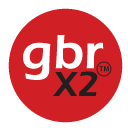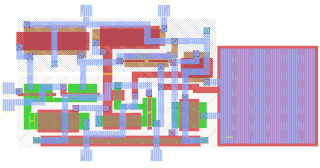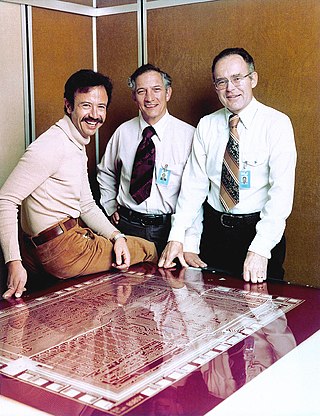Related Research Articles
In electronics and photonics design, tape-out or tapeout is the final stage of the design process for integrated circuits or printed circuit boards before they are sent for manufacturing. The tapeout is specifically the point at which the graphic for the photomask of the circuit is sent to the fabrication facility.
A photoplotter is a specialized electro-opto-mechanical machine that exposes a latent image on a medium, usually high-contrast monochromatic (black-and-white) photographic film, using a light source under computer control. Once the film has been exposed, it must be processed before it is ready for use.

A programmable logic device (PLD) is an electronic component used to build reconfigurable digital circuits. Unlike digital logic constructed using discrete logic gates with fixed functions, the function of a PLD is undefined at the time of manufacture. Before the PLD can be used in a circuit it must be programmed to implement the desired function. Compared to fixed logic devices, programmable logic devices simplify the design of complex logic and may offer superior performance. Unlike for microprocessors, programming a PLD changes the connections made between the gates in the device.

An application-specific integrated circuit is an integrated circuit (IC) chip customized for a particular use, rather than intended for general-purpose use, such as a chip designed to run in a digital voice recorder or a high-efficiency video codec. Application-specific standard product chips are intermediate between ASICs and industry standard integrated circuits like the 7400 series or the 4000 series. ASIC chips are typically fabricated using metal–oxide–semiconductor (MOS) technology, as MOS integrated circuit chips.
Electronic design automation (EDA), also referred to as electronic computer-aided design (ECAD), is a category of software tools for designing electronic systems such as integrated circuits and printed circuit boards. The tools work together in a design flow that chip designers use to design and analyze entire semiconductor chips. Since a modern semiconductor chip can have billions of components, EDA tools are essential for their design; this article in particular describes EDA specifically with respect to integrated circuits (ICs).
Applied Materials, Inc. is an American corporation that supplies equipment, services and software for the manufacture of semiconductor chips for electronics, flat panel displays for computers, smartphones, televisions, and solar products. The company also supplies equipment to produce coatings for flexible electronics, packaging and other applications. The company is headquartered in Santa Clara, California, and is the second largest supplier of semiconductor equipment in the world based on revenue behind ASML of Netherlands.

Programmable Array Logic (PAL) is a family of programmable logic device semiconductors used to implement logic functions in digital circuits that was introduced by Monolithic Memories, Inc. (MMI) in March 1978. MMI obtained a registered trademark on the term PAL for use in "Programmable Semiconductor Logic Circuits". The trademark is currently held by Lattice Semiconductor.
A photomask is an opaque plate with transparent areas that allow light to shine through in a defined pattern. Photomasks are commonly used in photolithography for the production of integrated circuits to produce a pattern on a thin wafer of material. In semiconductor manufacturing, a mask is sometimes called a reticle.

The Gerber format is an open, ASCII, vector format for printed circuit board (PCB) designs. It is the de facto standard used by PCB industry software to describe the printed circuit board images: copper layers, solder mask, legend, drill data, etc. The standard file extension is .GBR or .gbr though other extensions like .GB, .geb or .gerber are also used. It is documented by The Gerber Layer Format Specification and some related extensions such as XNC drill files and GerberJob to convey information about the entire PCB, as opposed to single layers.
Calma Company, based in Sunnyvale, California, was, between 1965 and 1988, a vendor of digitizers and minicomputer-based graphics systems targeted at the cartographic and electronic, mechanical and architectural design markets.
GDSII stream format (GDSII), is a binary database file format which is the de facto industry standard for Electronic Design Automation data exchange of integrated circuit or IC layout artwork. It is a binary file format representing planar geometric shapes, text labels, and other information about the layout in hierarchical form. The data can be used to reconstruct all or part of the artwork to be used in sharing layouts, transferring artwork between different tools, or creating photomasks.
Conexant Systems, Inc. was an American-based software developer and fabless semiconductor company that developed technology for voice and audio processing, imaging and modems. The company began as a division of Rockwell International, before being spun off as a public company. Conexant itself then spun off several business units, creating independent public companies which included Skyworks Solutions and Mindspeed Technologies.

Integrated circuit design, semiconductor design, chip design or IC design, is a sub-field of electronics engineering, encompassing the particular logic and circuit design techniques required to design integrated circuits, or ICs. ICs consist of miniaturized electronic components built into an electrical network on a monolithic semiconductor substrate by photolithography.
KLA Corporation is an American capital equipment company based in Milpitas, California. It supplies process control and yield management systems for the semiconductor industry and other related nanoelectronics industries. The company's products and services are intended for all phases of wafer, reticle, integrated circuit (IC) and packaging production, from research and development to final volume manufacturing.
Mask data preparation (MDP), also known as layout post processing, is the procedure of translating a file containing the intended set of polygons from an integrated circuit layout into set of instructions that a photomask writer can use to generate a physical mask. Typically, amendments and additions to the chip layout are performed in order to convert the physical layout into data for mask production.

Rubylith is a brand of masking film, invented and trademarked by the Ulano Corporation. Today the brand has become genericized to the point that it has become synonymous with all coloured masking films.
CR-5000 is Zuken's EDA design suite for electronic systems and printed circuit boards aimed at the enterprise market. It was developed to address complex design needs that involve managing the complete development and manufacturing preparation process on an enterprise-wide scale. CR-5000 is made to facilitate the design of complex and high-speed boards, with features aimed at addressing challenges such as signal integrity and electromagnetic compatibility.

In integrated circuit design, physical design is a step in the standard design cycle which follows after the circuit design. At this step, circuit representations of the components of the design are converted into geometric representations of shapes which, when manufactured in the corresponding layers of materials, will ensure the required functioning of the components. This geometric representation is called integrated circuit layout. This step is usually split into several sub-steps, which include both design and verification and validation of the layout.
In integrated circuits, the stepping level or revision level is a version number that refers to the introduction or revision of one or more photolithographic photomasks within the set of photomasks that is used to pattern an integrated circuit. The term originated from the name of the equipment ("steppers") that exposes the photoresist to light. Integrated circuits have two primary classes of mask sets: firstly, "base" layers that are used to build the structures, such as transistors, that comprise circuit logic and, secondly, "metal" layers that connect the circuit logic.

Read-only memory (ROM) is a type of non-volatile memory used in computers and other electronic devices. Data stored in ROM cannot be electronically modified after the manufacture of the memory device. Read-only memory is useful for storing software that is rarely changed during the life of the system, also known as firmware. Software applications, such as video games, for programmable devices can be distributed as plug-in cartridges containing ROM.
References
- 1 2 "NumeriTech Buying Transcription" Archived 2016-03-04 at the Wayback Machine , Gale Morrison, January 10, 2000, EDN Network (retrieved December 8, 2015)
- ↑ "Numeritech April 2000 SEC filing". Archived from the original on 2016-03-05. Retrieved 2015-12-09.
- ↑ ""NumeriTech to integrate mask design, preparation software after acquisition"". Archived from the original on 2016-03-04. Retrieved 2015-12-09.
- ↑ "Midnight at the OASIS" Archived 2016-03-04 at the Wayback Machine , an editorial at EDACafe, by Peggy Aycinena, September 11, 2006 (retrieved December 8, 2015)